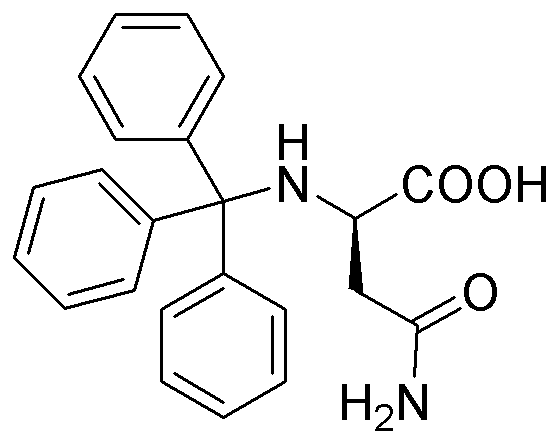Na-Trityl-D-asparagine is widely utilized in research focused on:
- Peptide Synthesis: This compound serves as a valuable building block in the synthesis of peptides, particularly for creating modified peptides that can enhance biological activity.
- Drug Development: It plays a role in the pharmaceutical industry, where it is used to develop new drugs that target specific biological pathways, improving efficacy and reducing side effects.
- Biotechnology: Researchers use it in various biotechnological applications, including the production of recombinant proteins, where it helps in optimizing yield and stability.
- Analytical Chemistry: The compound is employed in analytical methods for the characterization of amino acids and peptides, aiding in quality control and research analysis.
- Research on Neurotransmitters: It is involved in studies related to neurotransmitter function, providing insights into neurological disorders and potential therapeutic approaches.
General Information
Properties
Safety and Regulations
Applications
Na-Trityl-D-asparagine is widely utilized in research focused on:
- Peptide Synthesis: This compound serves as a valuable building block in the synthesis of peptides, particularly for creating modified peptides that can enhance biological activity.
- Drug Development: It plays a role in the pharmaceutical industry, where it is used to develop new drugs that target specific biological pathways, improving efficacy and reducing side effects.
- Biotechnology: Researchers use it in various biotechnological applications, including the production of recombinant proteins, where it helps in optimizing yield and stability.
- Analytical Chemistry: The compound is employed in analytical methods for the characterization of amino acids and peptides, aiding in quality control and research analysis.
- Research on Neurotransmitters: It is involved in studies related to neurotransmitter function, providing insights into neurological disorders and potential therapeutic approaches.
Documents
Safety Data Sheets (SDS)
The SDS provides comprehensive safety information on handling, storage, and disposal of the product.
Product Specification (PS)
The PS provides a comprehensive breakdown of the product’s properties, including chemical composition, physical state, purity, and storage requirements. It also details acceptable quality ranges and the product's intended applications.
Certificates of Analysis (COA)
Search for Certificates of Analysis (COA) by entering the products Lot Number. Lot and Batch Numbers can be found on a product’s label following the words ‘Lot’ or ‘Batch’.
*Catalog Number
*Lot Number
Certificates Of Origin (COO)
This COO confirms the country where the product was manufactured, and also details the materials and components used in it and whether it is derived from natural, synthetic, or other specific sources. This certificate may be required for customs, trade, and regulatory compliance.
*Catalog Number
*Lot Number
Safety Data Sheets (SDS)
The SDS provides comprehensive safety information on handling, storage, and disposal of the product.
DownloadProduct Specification (PS)
The PS provides a comprehensive breakdown of the product’s properties, including chemical composition, physical state, purity, and storage requirements. It also details acceptable quality ranges and the product's intended applications.
DownloadCertificates of Analysis (COA)
Search for Certificates of Analysis (COA) by entering the products Lot Number. Lot and Batch Numbers can be found on a product’s label following the words ‘Lot’ or ‘Batch’.
*Catalog Number
*Lot Number
Certificates Of Origin (COO)
This COO confirms the country where the product was manufactured, and also details the materials and components used in it and whether it is derived from natural, synthetic, or other specific sources. This certificate may be required for customs, trade, and regulatory compliance.


